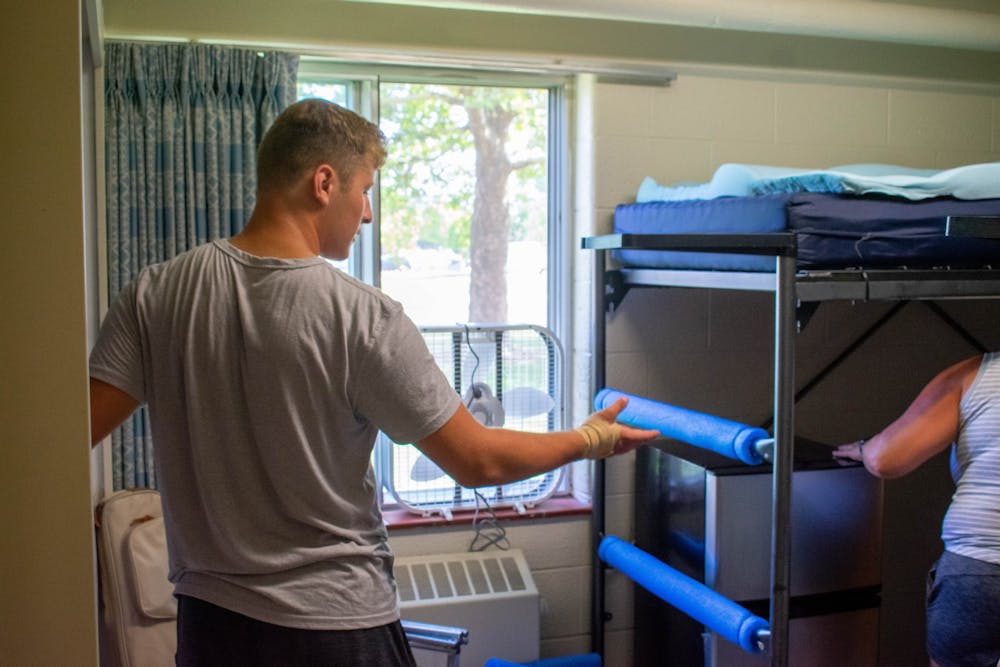
It's a sweltering August day and you're pushing a giant wooden cart filled to the brim with your belongings down a white, brick hallway. The wheels fight you against the carpet and the slight shifts in terrain.
You find the wooden door marked with a paper slip that has your name on it and push the cart into the large, bare room -- the room that will be yours for the next nine months.
There's four desks tucked into the far corner and a stale smell in the air. The light switches make an eerie chock sound when you turn them on, and the lights overhead buzz in response. It all feels a little odd and unsettling.
That is how I felt walking into my first dorm room in Sweeney Hall, and I believe many others likely feel the same way when they first move into the dorm. The sense of anxiety and sorrow of leaving my family behind overrode my fears of living alone for the first time; but once that passed I wasn't sure what to do with the four walls around me and how to find comfort in them.
As my junior year comes to an end, I've found myself getting attached to Sweeney's white walls, its occasionally temperamental washers and dryers, and the quick walks to all three dining halls on campus. Despite these bittersweet feelings, getting used to the place was not easy, and I stumbled and fumbled in the first few months.
If I can, I would like to help others not stumble as much as I did. You may still trip in the process, but hopefully these tips can help you recover much quicker.
Often times, when we move we worry about the big-ticket items -- furniture, storage, clothing and decorations. But during the stress of moving and the excitement of customizing our space, we can forget sometimes the simplest of items that we need to live.
For example:
These are small but important things that often get overlooked until you are in the dorm and the moment arises where they are needed.
Even if you never use these items, it's good to have them nearby in case of an emergency. As my mother always told me: "It's better to have it and not need it than to need it and not have it."
When moving in during the late summer months, there is one thing you might notice pretty quickly: It's hot. While you'd think stepping inside would fix that, that is not the case for the Central Michigan University dorms.
While they are equipped with heaters for the winter months, the rooms do not have centralized air. As most of our school science classrooms taught us, warm air rises and cool air sinks, so the heat only gets worse the higher up the floors you go.
It's advised to bring a fan with you on day one to prevent overheating. From my experience, oscillating fans work best because they can cover large areas or just focus on you, which can benefit roommates or visitors who may prefer different temperatures than you do.
It's important to make sure you have all of the resources you need to live comfortably in your dorm room; however, the second you arrive, you shouldn't dump everything and scatter it all over the place. If you have roommates, this will impede on their own space, and if you're by yourself it can create bad habits or just result in you misplacing things and struggling later.
I found that condensing things down was the most beneficial. I had to pack everything into a Toyota Prius, so condensing was already very much needed. But when I reached the dorm, I tried to keep my items condensed for space and for convenience.
I did this is a couple of ways, such as:
While this may not work for everyone, it works for me, and I advise doing it just to make move out period for breaks much easier.
The dorms have a lot of resources to help you get adjusted and to give you opportunities to ask questions about your surroundings.
Each floor has a designated Residential Assistant (RA) who will introduce themself to you within the first few weeks of attending CMU. Don't be afraid to ask them questions or reach out if any situations arise.
Their are various other people and resources within the residence halls as well, like:
For more information on resources and Residence Life staff, you can visit the CMU website and view staff members for Residence Life and for your specific dorm community.
One of the things I found the most helpful after I was settled in in my dorm was exploring the area outside of the dorm and knowing what was around me.
Good questions to answer early on:
A lot of these question can be answered by simply exploring your surroundings. Don't be afraid to look around during this time -- you're not the only one feeling lost and trying to figure things out, so let yourself experience beyond the four walls of your dorm as you settle in on campus.